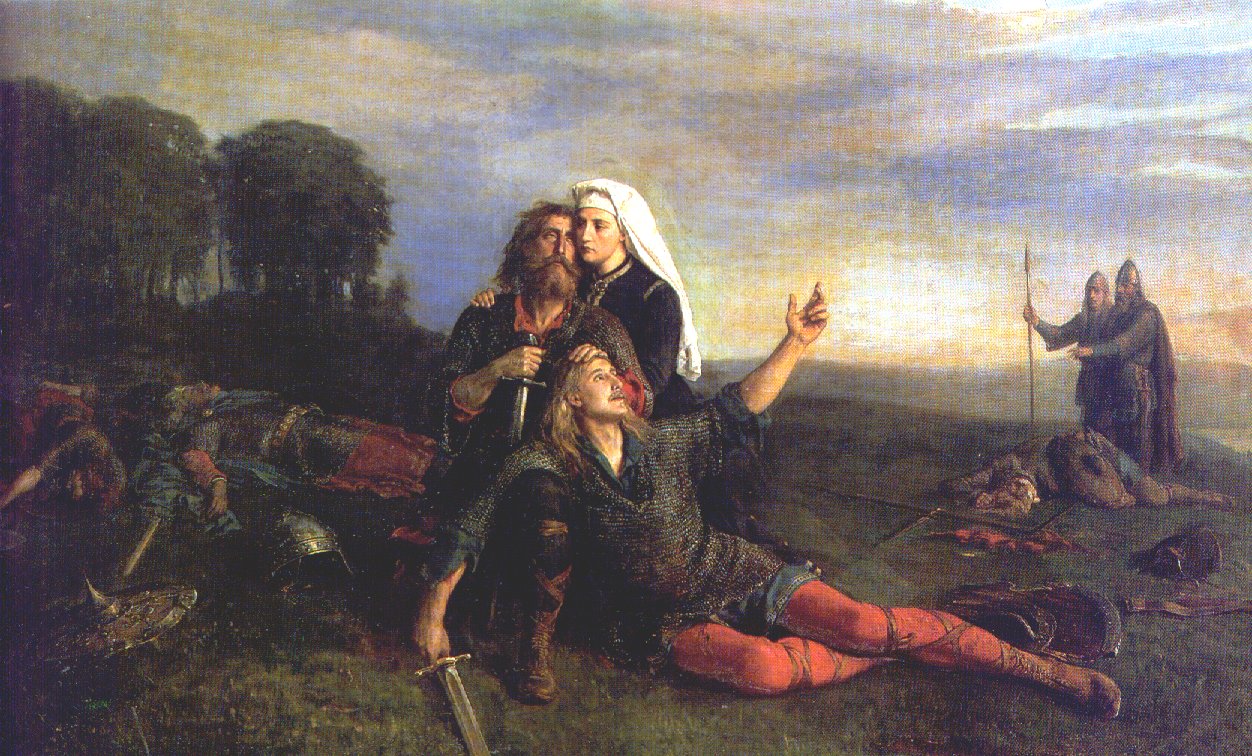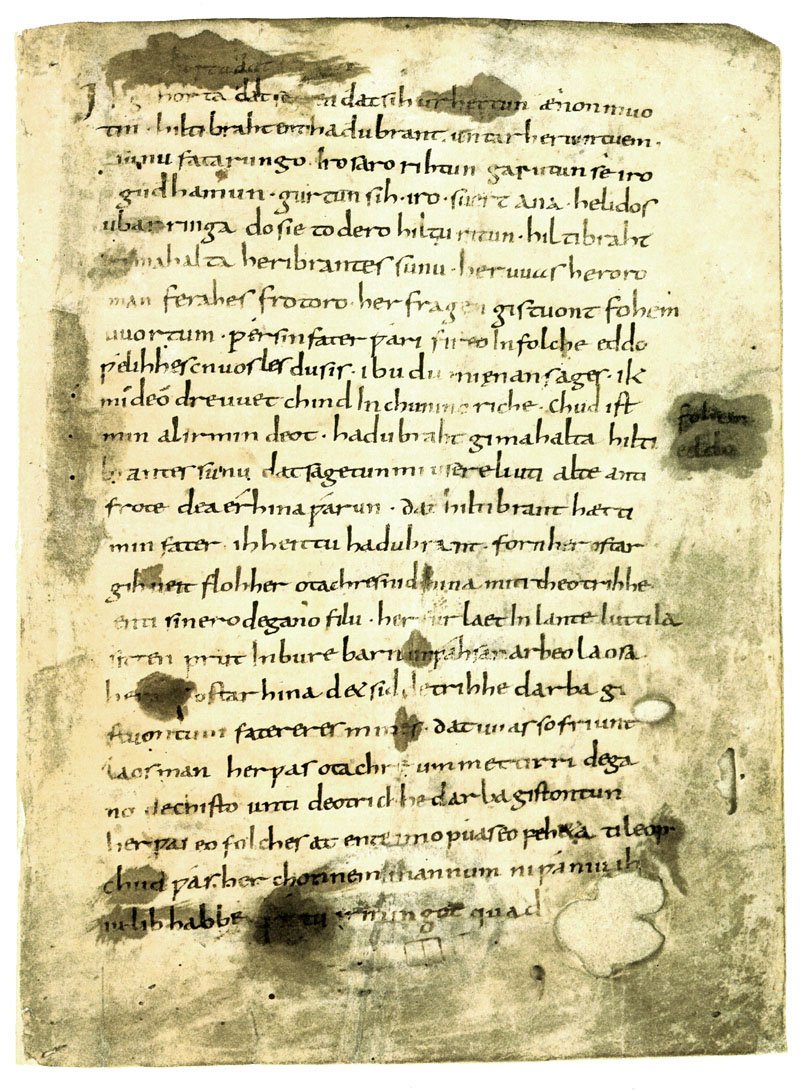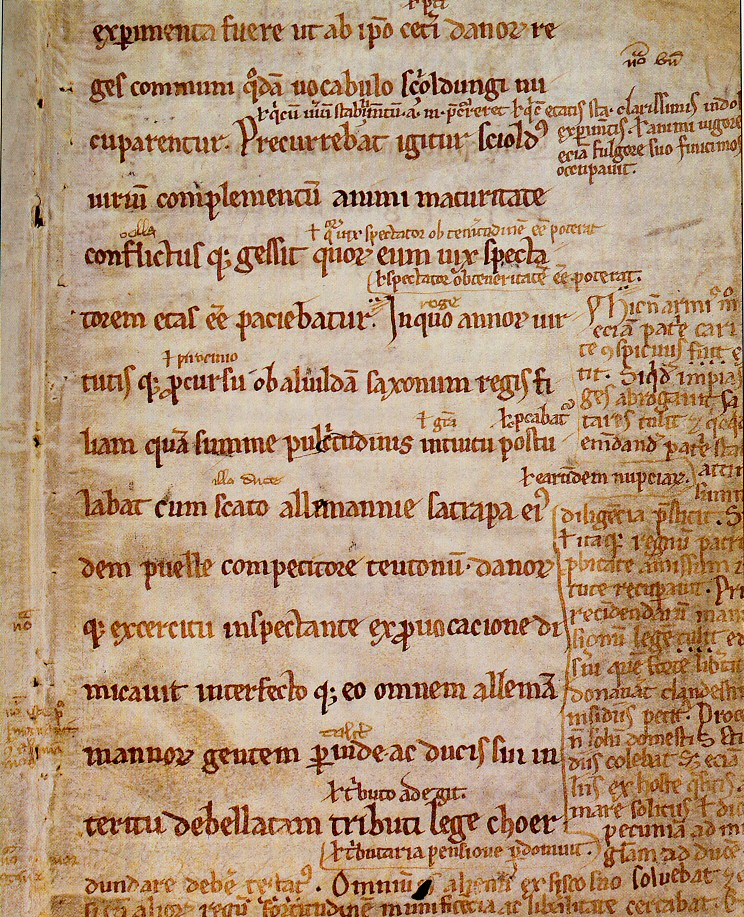|
Ásmundar Saga Kappabana
''Ásmundar saga kappabana'' is the saga of Asmund the Champion-Killer, a legendary saga from Iceland, first attested in the manuscript Stockholm, Royal Library, Holm. 7, 4to, from the first half of the fourteenth century.Ciklamini, M., ‘The Combat Between Two Half-Brothers; A Literary Study of the Motif in Ásmundar saga kappabana and Saxonis gesta Danorum’, Neophilologus, 50 (1966), 269–279, 370–79 DOI 10.1007/BF01515206, 10.1007/BF01515217. It is essentially an adaptation of the German ''Hildebrandslied'', but it has assimilated matter from the Tyrfing Cycle. Synopsis The saga relates that Hildebrand, the king of the Huns had a son named Helgi, who was married to Hild, the daughter of the Swedish king Budli. Helgi and Hild had a son who was raised by his grandfather and named Hildebrand after him. Hildebrand became a great warrior and was called the ''Hunnish champion''. When his father Helgi had fallen in a war, his maternal grandfather, the Swedish king Budli, was kil ... [...More Info...] [...Related Items...] OR: [Wikipedia] [Google] [Baidu] |
Legendary Saga
A legendary saga or ''fornaldarsaga'' (literally, "story/history of the ancient era") is a Norse saga that, unlike the Icelanders' sagas, takes place before the settlement of Iceland.The article ''Fornaldarsagor'' in ''Nationalencyklopedin'' (1991) There are some exceptions, such as '' Yngvars saga víðförla'', which takes place in the 11th century. The sagas were probably all written in Iceland, from about the middle of the 13th century to about 1400, although it is possible that some may be of a later date,Einar Ól. Sveinsson, "Fornaldarsögur", in ''Kulturhistorisk leksikon for nordisk middelalder fra vikingtid til reformasjonstid, bd. 4'' (Copenhagen, 1959) such as ''Hrólfs saga kraka''. Description of the sagas In terms of form, ''fornaldarsögur'' are similar to various other saga-genres, but tend towards fairly linear, episodic narratives. Like sagas in other genres, many quote verse, but in the ''fornaldarsögur'' that verse is almost invariably in the metre of Eddaic v ... [...More Info...] [...Related Items...] OR: [Wikipedia] [Google] [Baidu] |
Iceland
Iceland ( is, Ísland; ) is a Nordic island country in the North Atlantic Ocean and in the Arctic Ocean. Iceland is the most sparsely populated country in Europe. Iceland's capital and largest city is Reykjavík, which (along with its surrounding areas) is home to over 65% of the population. Iceland is the biggest part of the Mid-Atlantic Ridge that rises above sea level, and its central volcanic plateau is erupting almost constantly. The interior consists of a plateau characterised by sand and lava fields, mountains, and glaciers, and many glacial rivers flow to the sea through the lowlands. Iceland is warmed by the Gulf Stream and has a temperate climate, despite a high latitude just outside the Arctic Circle. Its high latitude and marine influence keep summers chilly, and most of its islands have a polar climate. According to the ancient manuscript , the settlement of Iceland began in 874 AD when the Norwegian chieftain Ingólfr Arnarson became the first p ... [...More Info...] [...Related Items...] OR: [Wikipedia] [Google] [Baidu] |
German Language
German ( ) is a West Germanic languages, West Germanic language mainly spoken in Central Europe. It is the most widely spoken and Official language, official or co-official language in Germany, Austria, Switzerland, Liechtenstein, and the Italy, Italian province of South Tyrol. It is also a co-official language of Luxembourg and German-speaking Community of Belgium, Belgium, as well as a national language in Namibia. Outside Germany, it is also spoken by German communities in France (Bas-Rhin), Czech Republic (North Bohemia), Poland (Upper Silesia), Slovakia (Bratislava Region), and Hungary (Sopron). German is most similar to other languages within the West Germanic language branch, including Afrikaans, Dutch language, Dutch, English language, English, the Frisian languages, Low German, Luxembourgish, Scots language, Scots, and Yiddish. It also contains close similarities in vocabulary to some languages in the North Germanic languages, North Germanic group, such as Danish lan ... [...More Info...] [...Related Items...] OR: [Wikipedia] [Google] [Baidu] |
Hildebrandslied
The ''Hildebrandslied'' (; ''Lay'' or ''Song of Hildebrand'') is a heroic lay written in Old High German alliterative verse. It is the earliest poetic text in German, and it tells of the tragic encounter in battle between a father (Hildebrand) and a son (Hadubrand) who does not recognize him. It is the only surviving example in German of a genre which must have been important in the oral literature of the Germanic tribes. The text was written in the 830s on two spare leaves on the outside of a religious codex in the monastery of Fulda. The two scribes were copying from an unknown older original, which itself must ultimately have derived from oral tradition. The story of Hildebrand and Hadubrand almost certainly goes back to 7th- or 8th-century Lombardy and is set against the background of the historical conflict between Theodoric and Odoacer in 5th-century Italy, which became a major subject for Germanic heroic legend. The fundamental story of the father and son who fail to recog ... [...More Info...] [...Related Items...] OR: [Wikipedia] [Google] [Baidu] |
Tyrfing Cycle
Tyrfing, Tirfing or Tyrving (the name is of uncertain origin, possibly connected to the Terwingi) was a magic sword in Norse mythology, which features in the Tyrfing Cycle, which includes a poem from the ''Poetic Edda'' called ''Hervararkvi√∞a'', and the Hervarar saga. The name is also used in the saga to denote the Goths. The form ''Tervingi'' was actually recorded by Roman sources in the 4th century. Svafrlami was the king of Gardariki, and Odin's grandson. He managed to trap the dwarfs Dvalinn and Durinn when they had left the rock where they dwelt. Then he forced them to forge a sword with a golden hilt that would never miss a stroke, would never rust and would cut through stone and iron as easily as through clothes. The dwarfs made the sword, and it shone and gleamed like fire. However, in revenge they cursed it so that it would kill a man every time it was drawn and that it would be the cause of three great evils. They finally cursed it so that it would also kill S ... [...More Info...] [...Related Items...] OR: [Wikipedia] [Google] [Baidu] |
Hildebrand
Hildebrand is a character from Germanic heroic legend. ''Hildebrand'' is the modern German form of the name: in Old High German it is ''Hiltibrant'' and in Old Norse ''Hildibrandr''. The word ''hild'' means "battle" and ''brand'' means "sword". The name itself is very likely of Lombardic origin. He is associated with the cycle of legends about Theodoric the Great, called Dietrich in German, to whom he is a companion. Hildebrand appears in many works, most prominently in the Old High German ''Hildebrandslied'', the Middle High German ''Nibelungenlied'', in the Old Norse song "Hildebrand's Death" in ''Ásmundar saga kappabana'' (called ''Hildibrandr''), and in the late medieval ''Jüngeres Hildebrandslied''. He also appears as ''Hildiger'' in ''Gesta Danorum''. In the Nibelungenlied, he is the armourer, brother-in-arms, and fatherly friend of Dietrich von Bern. Hildebrand kills Kriemhild, after she orders her brother's death and then kills Hagen herself. Hildebrand plays a suppo ... [...More Info...] [...Related Items...] OR: [Wikipedia] [Google] [Baidu] |
Huns
The Huns were a nomadic people who lived in Central Asia, the Caucasus, and Eastern Europe between the 4th and 6th century AD. According to European tradition, they were first reported living east of the Volga River, in an area that was part of Scythia at the time; the Huns' arrival is associated with the migration westward of an Iranian people, the Alans. By 370 AD, the Huns had arrived on the Volga, and by 430, they had established a vast, if short-lived, dominion in Europe, conquering the Goths and many other Germanic peoples living outside of Roman borders and causing many others to flee into Roman territory. The Huns, especially under their King Attila, made frequent and devastating raids into the Eastern Roman Empire. In 451, they invaded the Western Roman province of Gaul, where they fought a combined army of Romans and Visigoths at the Battle of the Catalaunian Fields, and in 452, they invaded Italy. After the death of Attila in 453, the Huns ceased to be a major thr ... [...More Info...] [...Related Items...] OR: [Wikipedia] [Google] [Baidu] |
Denmark
) , song = ( en, "King Christian stood by the lofty mast") , song_type = National and royal anthem , image_map = EU-Denmark.svg , map_caption = , subdivision_type = Sovereign state , subdivision_name = Danish Realm, Kingdom of Denmark , established_title = History of Denmark#Middle ages, Consolidation , established_date = 8th century , established_title2 = Christianization , established_date2 = 965 , established_title3 = , established_date3 = 5 June 1849 , established_title4 = Faroese home rule , established_date4 = 24 March 1948 , established_title5 = European Economic Community, EEC 1973 enlargement of the European Communities, accession , established_date5 = 1 January 1973 , established_title6 = Greenlandic home rule , established_date6 = 1 May 1979 , official_languages = Danish language, Danish , languages_type = Regional languages , languages_sub = yes , languages = German language, GermanGerman is recognised as a protected minority language in t ... [...More Info...] [...Related Items...] OR: [Wikipedia] [Google] [Baidu] |
Saxony
Saxony (german: Sachsen ; Upper Saxon: ''Saggsn''; hsb, Sakska), officially the Free State of Saxony (german: Freistaat Sachsen, links=no ; Upper Saxon: ''Freischdaad Saggsn''; hsb, Swobodny stat Sakska, links=no), is a landlocked state of Germany, bordering the states of Brandenburg, Saxony-Anhalt, Thuringia, Bavaria, as well as the countries of Poland and the Czech Republic. Its capital is Dresden, and its largest city is Leipzig. Saxony is the tenth largest of Germany's sixteen states, with an area of , and the sixth most populous, with more than 4 million inhabitants. The term Saxony has been in use for more than a millennium. It was used for the medieval Duchy of Saxony, the Electorate of Saxony of the Holy Roman Empire, the Kingdom of Saxony, and twice for a republic. The first Free State of Saxony was established in 1918 as a constituent state of the Weimar Republic. After World War II, it was under Soviet occupation before it became part of the communist East Ger ... [...More Info...] [...Related Items...] OR: [Wikipedia] [Google] [Baidu] |
Holmgang
Holmgang (holmganga in Old Norse, hólmganga in modern Icelandic, holmgång in Swedish, holmgang in Danish and Norwegian bokmål and nynorsk) is a duel practiced by early medieval Scandinavians. It was a legally recognized way to settle disputes. The name ''holmgang'' (literally " holm-going") may derive from the combatants' dueling on a small island, or ''holm'', as they do in the saga of Egill Skallagrímsson. At least in theory, anyone offended could challenge the other party to holmgang regardless of their differences in social status. This could be a matter of honor, ownership or property, demand of restitution or debt, legal disagreement or intention to help a wife or relative or avenge a friend. Holmgangs were fought 3–7 days after the challenge. If the person challenged did not turn up for the holmgang, the other man was considered just in his challenge. If the offended party did not turn up for the holmgang, they were deemed niðingr, and could have been sentenced t ... [...More Info...] [...Related Items...] OR: [Wikipedia] [Google] [Baidu] |
Gesta Danorum
''Gesta Danorum'' ("Deeds of the Danes") is a patriotic work of Danish history, by the 12th-century author Saxo Grammaticus ("Saxo the Literate", literally "the Grammarian"). It is the most ambitious literary undertaking of medieval Denmark and is an essential source for the nation's early history. It is also one of the oldest known written documents about the history of Estonia and Latvia. Consisting of sixteen books written in Latin on the invitation of Archbishop Absalon, ''Gesta Danorum'' describes Danish history and to some degree Scandinavian history in general, from prehistory to the late 12th century. In addition, ''Gesta Danorum'' offers singular reflections on European affairs in the High Middle Ages from a unique Scandinavian perspective, supplementing what has been handed down by historians from Western and Southern Europe. Books The sixteen books, in prose with an occasional excursion into poetry, can be categorized into two parts: Books 1–9, which deal with ... [...More Info...] [...Related Items...] OR: [Wikipedia] [Google] [Baidu] |







